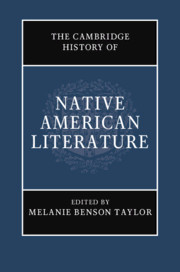Book contents
- The Cambridge History of Native American Literature
- The Cambridge History of Native American Literature
- Copyright page
- Contents
- Figures
- Contributors
- Introduction: What Was Native American Literature?
- Part I Traces and Removals (Pre-1870s)
- Part II Assimilation and Modernity (1879–1967)
- Part III Native American Renaissance (Post-1960s)
- 14 Rethinking the Native American Renaissance: Texts and Contexts
- 15 Marginally Mainstream: Momaday, Silko, Erdrich, and Alexie
- 16 Indigenous Lives, Visual Autobiographies
- 17 Indigenous Writing in Canada
- 18 Reservation Realities and Myths in American Literary History
- 19 Mapping the Future: Indigenous Feminism
- 20 Queer Sovereignty
- 21 Contemporary Indigenous American Poetry
- 22 Contemporary Native North American Drama
- Part IV Visions and Revisions: 21st-Century Prospects
- Index
- References
14 - Rethinking the Native American Renaissance: Texts and Contexts
from Part III - Native American Renaissance (Post-1960s)
Published online by Cambridge University Press: 18 September 2020
- The Cambridge History of Native American Literature
- The Cambridge History of Native American Literature
- Copyright page
- Contents
- Figures
- Contributors
- Introduction: What Was Native American Literature?
- Part I Traces and Removals (Pre-1870s)
- Part II Assimilation and Modernity (1879–1967)
- Part III Native American Renaissance (Post-1960s)
- 14 Rethinking the Native American Renaissance: Texts and Contexts
- 15 Marginally Mainstream: Momaday, Silko, Erdrich, and Alexie
- 16 Indigenous Lives, Visual Autobiographies
- 17 Indigenous Writing in Canada
- 18 Reservation Realities and Myths in American Literary History
- 19 Mapping the Future: Indigenous Feminism
- 20 Queer Sovereignty
- 21 Contemporary Indigenous American Poetry
- 22 Contemporary Native North American Drama
- Part IV Visions and Revisions: 21st-Century Prospects
- Index
- References
Summary
In the aftermath of House Made of Dawn (1968) the assumption arose that it heralded a Native American Renaissance, the unprecedented literary flowering of fiction, poetry, life-writing, drama and discursive work. The roster typically included novels by Leslie Marmon Silko, James Welsh, Louise Erdrich and Gerald Vizenor, the poetry of Luci Tapahonso, Simon Ortiz and Linda Hogan, and the theatre of Hanay Geiogamah. In Native American Renaissance, not un-controversially, Kenneth Lincoln would argue that a presiding canon had emerged. Questions, however, arose as to how to situate these undoubtedly important figures within the larger continuum of Native authorship. What status was to hold for the vast legacies of oral tradition, tribal oratory, trickster story, chants of healing, even visual art? How best to address Canadian/First Nation publication, E. Pauline Johnson to Tom King? What of contemporaries like Sherman Alexie? This chapter looks both vertically and horizontally to position the Native American Renaissance.
- Type
- Chapter
- Information
- The Cambridge History of Native American Literature , pp. 255 - 270Publisher: Cambridge University PressPrint publication year: 2020



